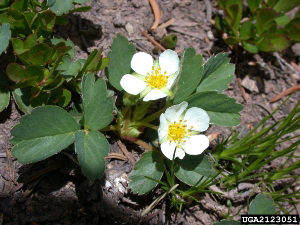Ninety-nine percent of the cultivars for our supermarket strawberries start with this species. The cultivated strawberry is an offspring of this species, and the beach strawberry (Fragaria chiloensis ) is from an accidental hybridization that occurred in Holland during the 1750s.
Photo Credit: © Mary Ellen (Mel) Harte, Bugwood.org.
Fragaria virginiana
Common Name: Virginia strawberry
Other Common Names: thickleaved wild strawberry
Plant Functional Group: Semi-evergreen forb
Class > Order > Family: Magnoliopsida > Rosales > Rosaceae
What does the species look like?
Virginia strawberry is a low-growing, perennial, herbaceous plant growing less than 1 foot tall. It can form patches by producing new plants at the end of runners (stolons) that can root nearby. Its showy, white flowers have both male and female parts, and are insect-pollinated.
Virginia strawberry is found in meadows and forest openings, and on open slopes. It also occurs in abandoned fields and travel corridors, at higher elevations where good frosts occur. It is occasionally found in sand dunes.
Where is the species found?
States & Provinces
AB, AK, AL, AR, AZ, BC, CA, CO, CT, DC, DE, FL, GA, IA, ID, IL, IN, KS, KY, LA, MA, MB, MD, ME, MI, MN, MO, MS, MT, NB, NC, ND, NE, NH, NJ, NL, NM, NS, NT, NU, NV, NY, OH, OK, ON, OR, PA, PE, QC, RI, SC, SD, SK, TN, TX, UT, VA, VT, WA, WI, WV, WY, YT
Special Considerations for Observing
If drought seems to be the cause of leaf senescence for a plant, please make a comment about it for that observation.
Which phenophases should I observe?
Do you see...?
Leaves
Initial growth More...
Young leaves
Leaves More...
Flowers
Flowers or flower buds More...
How many flowers and flower buds are present? For species in which individual flowers are clustered in flower heads, spikes or catkins (inflorescences), simply estimate the number of flower heads, spikes or catkins and not the number of individual flowers.
Less than 3 3 to 10 11 to 100 101 to 1,000 More than 1,000
Open flowers More...
What percentage of all fresh flowers (buds plus unopened plus open) on the plant are open? For species in which individual flowers are clustered in flower heads, spikes or catkins (inflorescences), estimate the percentage of all individual flowers that are open.
Less than 5% 5-24% 25-49% 50-74% 75-94% 95% or more
Fruits
Fruits Fragaria virginiana , the fruit is tiny and seed-like and is imbedded on the surface of a berry-like "strawberry". The strawberry changes from greenish-white or green to bright red.More...
How many fruits are present?
Less than 3 3 to 10 11 to 100 101 to 1,000 More than 1,000
Ripe fruits Fragaria virginiana , the fruits are considered ripe when the strawberry has turned bright red.More...
What percentage of all fruits (unripe plus ripe) on the plant are ripe?
Less than 5% 5-24% 25-49% 50-74% 75-94% 95% or more
Recent fruit or seed drop More...
How many mature fruits have dropped seeds or have completely dropped or been removed from the plant since your last visit?
Less than 3 3 to 10 11 to 100 101 to 1,000 More than 1,000
What do these phenophases look like?
There is currently no photoguide available for this species. If you'd like help us create one, use the guidance document and species template provided here . Then send it via email to education@usanpn.org when it is complete.
